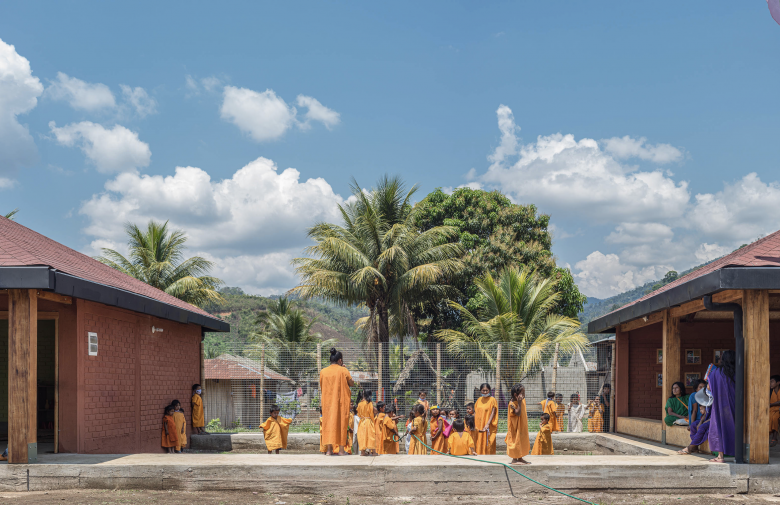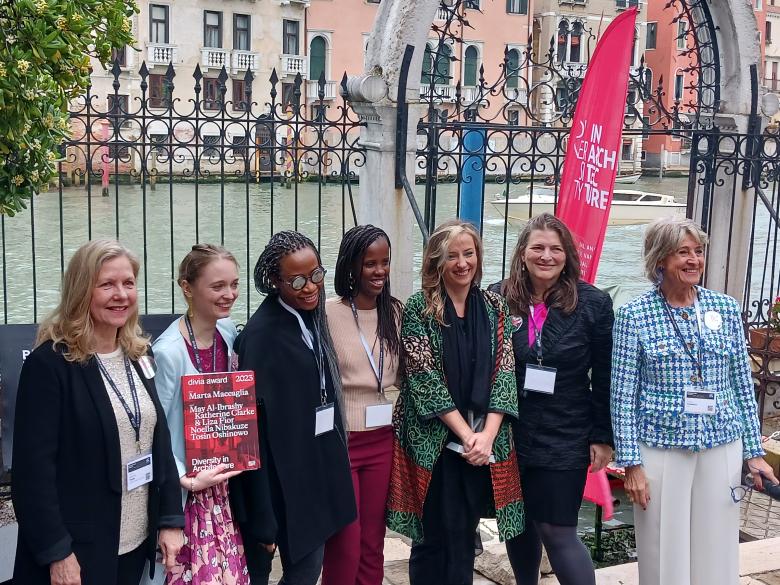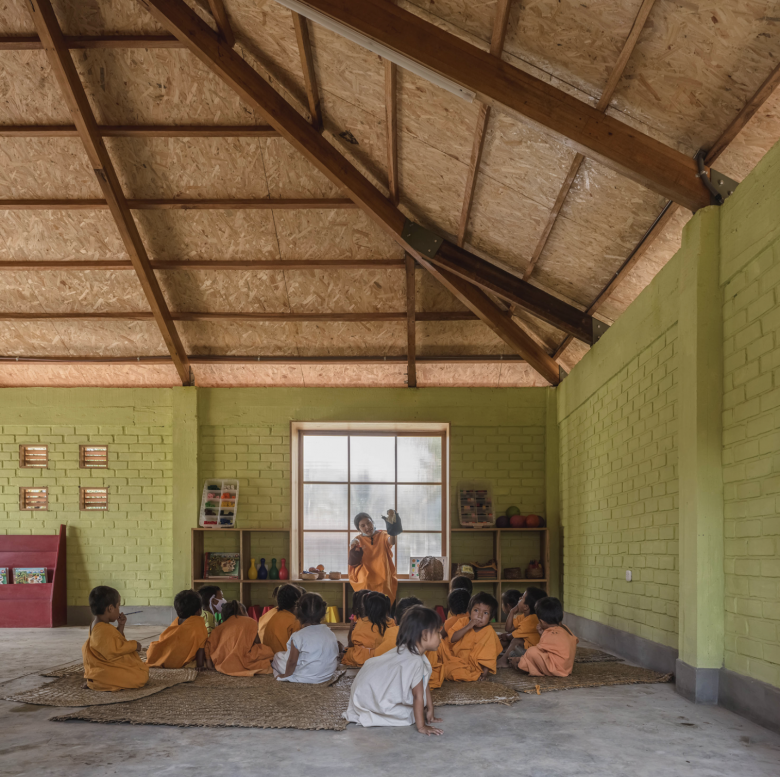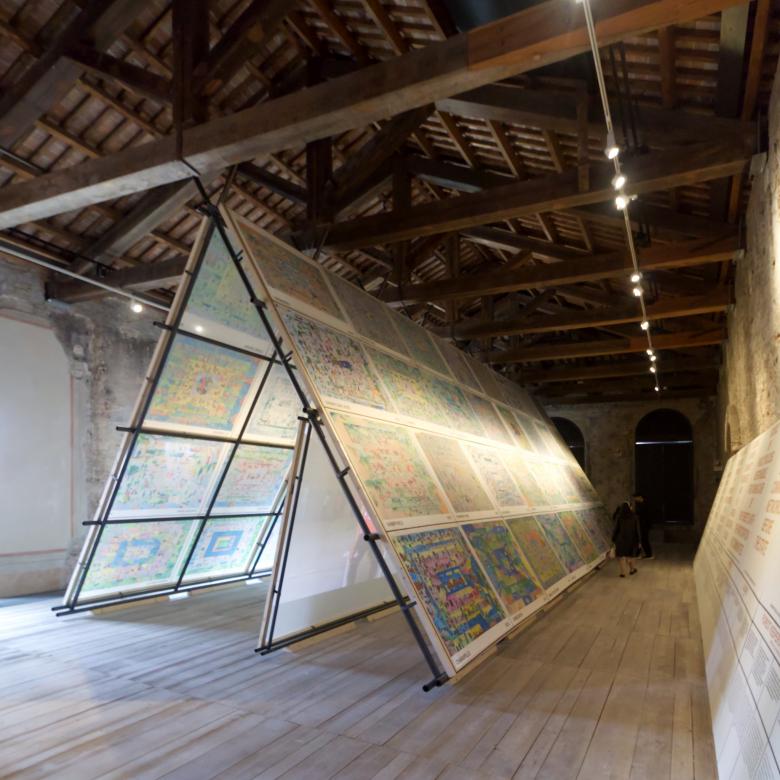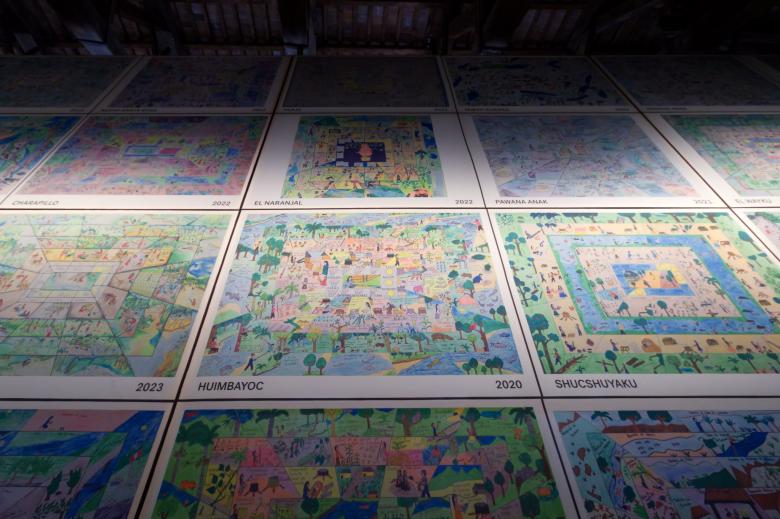6. July 2023
Nursery School, Alto Anapati, 2021. Funding: Fly & Help and Municipalidad de Pangoa (Photo: Eleazar Cuadros)
Back in May, the winner of the inaugural divia award was announced in Berlin and then celebrated in Venice, the latter coinciding with the opening of this year's Architecture Biennale. World-Architects spoke with winner Marta Maccaglia about what the divia award means to her, building schools in the Peruvian jungle, and her impressions on Walkers in Amazonia, the Peru Pavilion at the Biennale.
On May 19, one day before the opening of the 2023 Venice Architecture Biennale, a group gathered at Palazzo Contarini Polignac to congratulate divia award winner Marta Maccaglia, the Italian-born architect who founded Asociación Semillas to build schools in Peru’s Amazonian region. Featuring comments by award founder Ursula Schwitalla, Maccaglia and some of her fellow finalists, and juror Martha Thorne, the reception capped the first cycle of the biennial divia award. It was launched in June 2021 as a platform “to make women architects visible, to recognize and honor their work, to promote equality between male and female architects, and to raise awareness of role models for young women architects.” Even the rain could not dampen the festive occasion, which also included a brief presentation of the catalogue published by Hatje Cantz and plenty of spritz-fueled conversation. World-Architects editor John Hill met Maccaglia the following day at Café Paradiso outside the Biennale gates to talk about divia, Semillas, Peru, and the Amazonian presence at the Venice Architecture Biennale. The conversation has been edited for clarity and length.
Left to right: Juror Martha Thorne, divia award book editor Veronika Lukashevich, finalist Tosin Oshinowo, finalist Noella Nibakuze, winner Marta Maccaglia, finalist Liza Fior, and divia award chief and founder Ursula Schwitalla at the award reception at Palazzo Contarini Polignac on May 19, 2023. (Photo: John Hill/World-Architects)
John Hill (JH): How did you react when you learned that you were nominated for the divia award? Did you even know the award existed?Marta Maccaglia (MM): This is the first edition of the award, so I didn't know about it. But it was made by Anna Heringer, Odile Decq, and other women architects I appreciate a lot, who inspired me at some moments in my career. I was surprised when I was nominated. There were 25 or 27 of us architects around the world, so I thought, “Wow!” [laugh], “I'm there!” When I was named a finalist, I was also surprised. I didn't expect anything. So, in Berlin, when they announced that I won the prize, my reaction was … a bit emotional. I am very proud of the prize. I think Semillas is an office that symbolizes diversity, so I’m proud that we received this prize. Yes, there is my face, of course, and I'm the founder and leader and I manage the association, but it is a collective; it is work from a lot of contributors. This prize means a lot for us because it will help open the door for some other possibilities.
JH: Is part of your work with Semillas, the nonprofit you established, to find funding for all your projects? Is that hard? Might this prize help make it easier?
MM: It is very hard work. Ours is not a typical architecture studio where the client comes to us. In our case, we find the community… and sometimes the communities find us. We have a long list of communities that need help, and we work with the Ministry of Education to determine which community’s kids and students need help now. After that, we apply for funding, sometimes with a foundation from Europe. We have started projects with, and thanks to, Volcafe Speciality (VSP) Peru Generaciones and the Costa Foundation, we have opened cooperation with the NGO CPS from Italy, and now with Fly & Help Foundation and the German Ministry of Development through the NGO We-Building. It's a very slow process that takes years. And it’s a specialization; the writing is very complex, it has social research and a lot of data. But I really enjoy it. It is an opportunity to research the context, the territory, the culture, the social situations, the level of education… All the research helps us to deeply know the communities where we work.
One of the most difficult things is to have a team, a fixed team. For me, it's so fundamental to have a team trained, not only in architecture, but with geographical vision and anthropological knowledge…
JH: How many people are on your team right now?
MM: Now we are eight. We are six architects, women architects. Three of us are from Italy and three are from different cities in Peru. There is also an accountant and a lawyer who help me manage things.
I think all these aspects of Semillas contribute to us making our designs very authentic. And, in the atmospheres of our projects, I think you can see happiness. Because it is step-by-step with the community. It was not easy at the beginning, because communities didn’t accept us — or me, alone. There are a lot of histories in Peru about white people who did bad things with kids. It is a narco-trafficking area that suffered the consequences of the armed conflict in Peru. It's a complicated area. But now, because we have an agreement with native community associations, we involve the community from the first step. In term of funding, it is difficult. Fifty percent is from international corporations, fifty percent from the local government, mainly the municipalities. Our hard work is to manage all of these together.
In this way, the design of the projects is very important because, for us, architecture has a strong power in daily life. We try to interpret the well-being of a native community. We go to the communities, we learn and we listen to create buildings that are coherent with the context, with the spirit of the community. And the school is the most important infrastructure because it is often the only public infrastructure in the community. There are maybe one hundred families there; they are small communities.
Nursery School, Alto Anapati, 2021. Funding: Fly & Help and Municipalidad de Pangoa (Photo: Eleazar Cuadros)
JH: I live in New York and am thinking about architecture firms there that also do things differently than the norm. Some of these firms like to have employees learn their unique process and then start their own firms, carrying that knowledge with them — so it kind of spreads. Do you hope to do something like that with Semillas?MM: Yes, of course. I think the concept of Semillas — its philosophy — could be multiplied in different aspects. In the university, I had a workshop with Al Borde, an Ecuadorian office, in which students worked in human settlements in Lima. We built together with the students and the community, teaching the students this participatory method: listening and designing from the needs of the community so the designs were results of social reflection. After that, and after technical design, we taught the students to interpret the law in the implementation of Peruvian education, to make a very serious and disciplined technical presentation to the community. We taught them to connect with the context: the materials we had, the budget, and other parameters that are in a normal, professional life. In the university, most proposals to students are not real projects — this is a real project. The students managed a small budget, got donations of materials from companies, and built the project. For me, teaching is a way to spread the methodology and the way I see architecture.
JH: Are there architects and studios — I’m thinking of Rural Studio in Alabama — who inspire you, who similarly have worked with local communities to determine what they need?
MM: Yes, of course. At the beginning it was intuitive for me to make things, because I was in the jungle alone, and I understood that a design without process couldn't function. After the experience I could reflect on the references. In Italy, for example, the participatory design of Giancarlo de Carlo, who designed my own city’s district, is very important for me, to see architecture as an interdisciplinary team. Herman Hertzberger in reference to the architecture of schools. In Latin America, too, there are a group of architects that are making very good architecture, such as Al Borde from Ecuador and Solano Benítez from Paraguay. And there is a group of very strong women from Mexico making very good architecture in different ways, using local materials and promoting public infrastructure. Latin America is an inspiration, really, but the communities are the best inspiration because they changed my way of thinking. We are so individualistic in Europe, but in a native community this idea of private property doesn't exist; only communal property. It’s this concept that you are in life for 50 or 60 or 70 years, so it's not the power to have things, but to have a common world. It’s fascinating, this way of seeing life.
Pavilion of Peru, Walkers in Amazonia: The Calendar Project (Photo: John Hill/World-Architects)
JH: What do you think about the Peru Pavilion, Walkers in Amazonia: The Calendar Project?
MM: I really love the jungle because I learn a lot there, so I am glad that Peru is speaking about the jungle in the Biennale. In Peru, the Amazonian forest only existed for the exploitation of resources. The jungle is 61% of the territory of Peru, but from outside, when you think about Peru, what do you think?
JH: Machu Picchu
MM: Yes, Machu Picchu and the Incas. When I say I live in Peru, people say, “Ah, you are so high up!” No, I’m on the coast [laughs] — Lima is by the ocean. It is a very diverse country with different types of cultures and territories: coastal desert, Andean mountains, and the jungle. The jungle is the most important, not just because of size. There are 42 languages in Peru, and most of them are Amazonian. So, I'm very proud of this pavilion. I think the work of Alexia León [curator, with Lucho Marcial] is very serious, done with an NGO that works in the San Martín region.
The shape of the pavilion is very elegant and minimal. And the use of the calendar as a drawing for the structure is very powerful. You feel like you are inside time, because the drawings are about time and the concept of time in native communities. When I saw it, I thought of the participatory process that we do with communities, because their concept of time is different. For example, we do an exercise in which we try to connect the activities of the school with the calendar of the community; the calendar is connected with land, river, fishing, agriculture, all these things. In the Peru Pavilion, time is not linear, because it is connected with the different layers of the territory. It's so amazing. I think Alexia, in the way it’s represented, understood this aspect. I love the pavilion. I’m very critical, mainly in the jungle, but in this case, I think it's a very good work.
Pavilion of Peru, Walkers in Amazonia: The Calendar Project (Photo: John Hill/World-Architects)
JH: Am I understanding correctly, that there are as many calendars as there are languages?MM: Not really. It's kind of similar because it is connected with the territory, with the sun, with the river… So, it’s a circular concept of time, not January, February, March, … When we would prepare a participatory worship, we would have a poster with January, February, the months of the year, and they thought, “Oh my God, no!” So, in the years since I understood the concept of time for the communities, we only give the group white paper and names. It’s very interesting, I think. And it is connected with urban planning, with design; it’s not separate, it's connected completely. And the main question is: How can we reflect this in the design? Normally the Peruvian government uses standard infrastructure for the communities. We are very critical about that, because we think design has a responsibility to represent the community.
Thank you very much.
